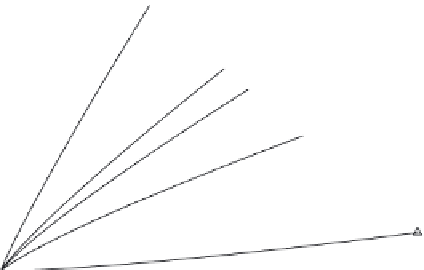Agriculture Reference
In-Depth Information
50
Imidacloprid Isotherm
(24h reaction)
Mahan
Mhoon
Sharkey
Vacherie
Sand
Freundlich
40
30
20
10
0
0
5
10
15
20
Imidacloprid in Solution (mg L
-1
)
FIGURE 2.3
Adsorption isotherms for imidacloprid for five different retention soils. The solid curves are
based on the Freundlich equation.
the dominant sorbent for imidoclorpid in a Vacherie soil with high organic
matter. There are not many other examples of apparent linear kinetics for
other solutes, with the exception of cations of low affinity such as Ca, K, and
Na (Gaston and Selim, 1990a, 1990b).
Kinetic sorption that exhibits nonlinear or curve linear retention behavior
is commonly observed for several reactive chemicals as depicted by the non-
linear isotherms for nickel and arsenic shown in Figures 2.4 and 2.5, respec-
tively (Liao and Selim, 2010, and Zhang and Selim, 2005). To describe such
nonlinear behavior, the single reaction given in Equation 2.1 is commonly
extended to include nonlinear kinetics such that (Selim 1992):
∂
∂
S
t
θ
ρ
b
=
k
CkS
−
(2.2)
f
b
where
b
is a dimensionless parameter commonly less than unity and rep-
resents the order of the nonlinear or concentration-dependent reaction and
illustrates the extent of heterogeneity of the retention processes. This non-
linear reaction (Equation 2.2) is fully reversible where the magnitudes of
the rate coefficients dictate the extent of kinetic behavior of retention of the
solute from the soil solution. For small values of
k
f
and
k
b
, the rate of reten-
tion is slow and strong kinetic dependence is anticipated. In contrast, for
large values of
k
f
and
k
b
, the retention reaction is a rapid one and should
approach quasi-equilibrium in a relatively short time. In fact, at large times























Search WWH ::

Custom Search